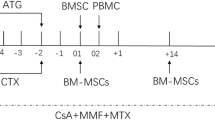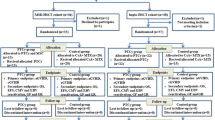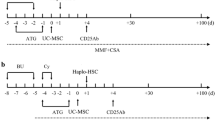Abstract
Five young patients with a long history of severe aplastic anemia (SAA) who had failed initial CSA treatment and lacked a HLA-matched sibling donor, underwent co-transplantation of unrelated donor peripheral blood stem cells (UD-PBSCs) and umbilical cord mesenchymal/stroma stem cells (UC-MSCs). After FLU + CTX + ATG ± 2GY TBI conditioning, all patients received UD-PBSCs and UC-MSCs. There were no side effects attributable to the infused MSCs, and no severe complications or infections were observed in any patient after transplantation. After transplantation, one patient experienced primary graft failure, the reason for which may be related to a long history (>17 years) of SAA. The other four patients achieved complete hematopoietic recovery and complete donor hematopoietic chimerism. We did not observe severe aGVHD or cGVHD. These data suggest that co-transplantation of UD-PBSCs and UC-MSCs is an acceptable alternative treatment for young patients with a long history of intensively treated SAA.
Similar content being viewed by others
References
Camitta BM, Thomas ED, Nathan DG, et al. Severe aplastic anemia: a prospective study of the effect of early marrow transplantation on acute mortality. Blood. 1976;48:63–9.
Kang HJ, Shin HY, Park JE, et al. Successful engraftment with fludarabine, cyclophosphamide, and thymoglobulin condition-ing regimen in unrelated transplantation for severe aplastic anemia: a phase II prospective multicenter study. Biol Blood Marrow Transplant. 2010;16:1582–8.
Tichelli A, Schrezenmeier H, Socie G, et al. A randomized controlled study in patients with newly diagnosed severe aplastic anemia receiving antithymocyte globulin (ATG), cyclosporine, with or without G-CSF: a study of the SAA Working Party of the European Group for blood and marrow transplantation. Blood. 2011;117:4434–41.
Peinemann F, Grouven U, Kroger N, et al. First-line matched related donor hematopoietic stem cell transplantation compared to immunosuppressive therapy in acquired severe aplastic anemia. PLoS One. 2011;6:18572.
Scheinberg P, Wu CO, Nunez O, et al. Predicting response to immunosuppressive therapy and survival in severe aplastic anaemia. Br J Haematol. 2009;144:206–16.
Scheinberg P, Young NS. How I treat acquired aplastic anemia. Blood. 2012;120:1185–96.
Scheinberg P. Aplastic anemia: therapeutic updates in immunosuppression and transplantation. Hematol Am Soc Hematol Educ Program. 2012;2012:292–300.
Peinemann F, Grouven U, Kroger N, et al. Unrelated donor stem cell transplantation in acquired severe aplastic anemia: a systematic review. Haematologica. 2009;94:1732–42.
Urban C, Benesch M, Sovinz P, et al. Alternative donor HSCT in refractory acquired aplastic anemia—prevention of graft rejection and graft versus host disease by immunoablative conditioning and graft manipulation. Pediatr Transplant. 2012;16:577–81.
Gupta V, Eapen M, Brazauskas R, et al. Impact of age on outcomes after bone marrow transplantation for acquired aplastic anemia using HLA-matched sibling donors. Haematologica. 2010;95:2119–25.
Bacigalupo A, Socie’ G, Lanino E, et al. Fludarabine, cyclophosphamide, antithymocyte globulin, with or without low dose total body irradiation, for alternative donor transplants, in acquired severe aplastic anemia: a retrospective study from the EBMT-SAA working party. Haematologica. 2010;95:976–82.
Maury S, Aljurf M. Management of adult patients older than 40 years refractory to at least one immunosuppressive course: HLA-identical sibling HSCT using fludarabine-based conditioning. Bone Marrow Transplant. 2013;48:196–7.
Aggarwal S, Pittenger MF. Human mesenchymal stem cells modulate allogeneic immune cell responses. Blood. 2005;105:1815–22.
Selmani Z, Naji A, Zidi I, et al. Human leukocyte antigen-G5 secretion by human mesenchymal stem cells is required to suppress T lymphocyte and natural killer function and to induce CD4+CD25 highFOXP3+ regulatory T cells. Stem Cells. 2008;26:212–22.
Tse WT, Pendleton JD, Beyer WM, et al. Suppression of allogeneic T-cell proliferation by human marrow stromal cells: implications in transplantation. Transplantation. 2003;75:389–97.
Coliţă A, Coliţă A, Zamfirescut D, et al. Combined procedure of vascularized bone marrow transplantation and mesenchymal stem cells graft—an effective solution for rapid hematopoietic reconstitution and prevention of graft-versus-host disease. Med Hypotheses. 2012;79:302–3.
Ball LM, Bernardo ME, Roelofs H, et al. Cotransplanta-tion of ex vivo-expanded mesenchymal stem cells accelerates lymphocyte recovery and may reduce the risk of graft failure in haploidentical hematopoietic stem-cell transplantation. Blood. 2007;110:2764–7.
Baron F, Lechanteur C, Willems E, et al. Cotransplantation of mesenchymal stem cells might prevent death from graft-versus-host disease (GVHD) without abrogating graft-versus-tumor effects after HLA-mismatched allogeneic transplan-tation following nonmyeloablative conditioning. Biol Blood and Marrow Transplant. 2010;16:838–47.
Gong W, Han ZB, Zhao H, et al. Banking human umbilical cord-derived mesenchymal stromal cells for clinical use. Cell Transplant. 2012;21:207–16.
Maury S, Bacigalupo A, Anderlini P, et al. Improved outcome of patients older than 30 years receiving HLA-identical sibling hematopoietic stem cell transplantation for severe acquired aplastic anemia using fludarabine-based conditioning: a comparison with conventional conditioning regimen. Haematologica. 2009;94:1312–5.
Perez-Simon JA, Lopez-Villar O, Andreu EJ, et al. Mesenchymal stem cells expanded in vitro with human serum for the treatment of acute and chronic graft-versus-host disease: results of a phase I/II clinical trial. Haematologica. 2011;96:1072–6.
Gonzalo-Daganzo R, Regidor C, Martín-Donaire T, et al. Results of a pilot study on the use of third-party donor mesenchymal stromal cells in cord blood transplantation in adults. Cytotherapy. 2009;11:278–88.
Chao YH, Tsai C, Peng CT, et al. Cotransplantation of umbilical cord MSCs to enhance engraftment of hematopoietic stem cells in patients with severe aplastic anemia. Bone Marrow Transplant. 2011;46:1391–2.
Wang H, Yan H, Wang Z, et al. Cotransplantation of allogeneic mesenchymal and hematopoietic stem cells in children with aplastic anemia. Pediatrics. 2012;129:1612–5.
Kinnaird T, Stabile E, Burnett MS, Lee CW, Barr S, Fuchs S, et al. Marrow-derived stromal cells express genes encoding a broad spectrum of arteriogenic cytokines and promote In Vitro and In Vivo arteriogenesis through paracrine mechanisms. Circ Res. 2004;94:678–85.
Acknowledgments
We thank all participating doctors and patients who were involved in the study.
Conflict of interest
The authors declare no conflict of interest.
Author information
Authors and Affiliations
Corresponding author
About this article
Cite this article
Fu, Y., Wang, Q., Zhou, J. et al. Reduced intensity conditioning and co-transplantation of unrelated peripheral stem cells combined with umbilical cord mesenchymal stem/stroma cells for young patients with refractory severe aplastic anemia. Int J Hematol 98, 658–663 (2013). https://doi.org/10.1007/s12185-013-1425-6
Received:
Revised:
Accepted:
Published:
Issue Date:
DOI: https://doi.org/10.1007/s12185-013-1425-6




